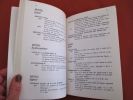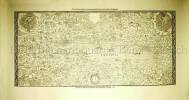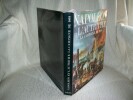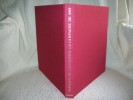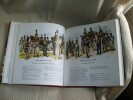-
Type
Book (1122)
Drawings (1)
Magazine (10)
Maps (57)
-
Latest
Last 24h (2)
Last 3 days (1)
Last month (5)
Last week (1)
-
Language
English (1)
French (1185)
German (3)
Portuguese (1)
-
Century
16th (4)
17th (27)
18th (56)
19th (161)
20th (228)
21st (51)
-
Countries
Belgium (262)
Brazil (1)
Canada (5)
China (1)
Côte d'Ivoire (4)
France (647)
Italy (46)
Switzerland (224)
-
Syndicate
ALAC (5)
ILAB (390)
NVVA (130)
SLACES (130)
SLAM (148)
SNCAO (2)
Plans et profilz des principales villes de la province de Champagne, avec la carte générale & les particulières de chascun gouvernements d’icelles.
s. l. (Paris), , s. l. (Paris), (vers 1630) ; in-8 oblong, demi-basane rose, dos lisse orné de motifs dorés. (Reliure du XIXe siècle). Titre gravé dans un encadrement baroque de rocailles, table gravée, 51 planches numérotées pour ce titre auxquelles on a ajouté 15 autres gravures.Cartes des gouvernements, plans et vues des villes. Les plans de Champagne concernent les principales villes de l’actuelle Champagne, mais aussi les Ardennes et la Lorraine. Ay, Chaalons, Charleville, Chaumont, Clermont, Dormans, Espernay, Langres, Maubert Fontaine, Mery sur Seine, Meszière, Monteclair, Montigny le Roy, Mouzon, Ste Menehould, Troyes, Verdun, Villefranche, Virty le François. Pour chaque gouvernement, une carte de la région, chaque ville est ensuite représentée par un plan et une vue. La table annonce pour la planche 29 un plan de Maubert-Fontaine, elle a été remplacée ici par une vue de Dampierre non numérotée qui n’est pas annoncée dans la table. Les 15 cartes et vues ajoutées sont du même format, certaines, du XVIIe, de la même facture que l’album, semblent être également de Tassin, d’autres sont plus tardives, toutes montrent des vues et plans de villes de Champagne. Certaines planches, en particulier les figues ajoutées, ont été montés sur papier vergé par le relieur du XIXe siècle qui a aussi doublé un marge. De la bibliothèque de Louis Morin, typographe à Troyes (ex-libris du XIXe), ce dernier a noté sur la garde : “Il a été ajouté des vues et plans, ce qui (...) rend le présent recueil des plus intéressants”.
Cote, dunes, Polders. Atlas de Belgique, planche 17.
, Brussel, Koninklijke Belgische Academie, 1970., softcover, Broche, couverture d' editeur, 29,5x21cm, 32pp.
Royaume de Belgique. Comite national de geographie. Commission de l' atlas national. Atlas de Belgique, planche 17.
Kust, duinen, polders, atlas van Belgie, blad 17.
, Brussel, Koninklijke Belgische Academie, 1970., softcover, 29,5x21cm, 32pp. Nederlands,
Royaume de Belgique. Comite national de geographie. Commission de l' atlas national. Atlas de Belgique, planche 17.
Cartas antigas da India existentes em Portugal (séculos XVIII, XIX, e XX)
Junta De in Vestigaçoes Cientificas Do Ultramar 21,5 x 29 Lisboa 1979 Centro de Estudos de Cartografia Antiga. Vol. CXVI secçao de Lisboa, broché, 125 p. Description de 274 cartes, 16 fac-similés. Indice geografico. Exemplaire en parfait état. Livre
Très bon
The continent of America. Its discovery and its baptism. An essay on the nomenclature of the old continents. A critical and bibliographical inquiry into the naming of America and into the growth of the cosmography of the new world; together with an attempt to establish the landfall of Columbus on Watlin Island, and the subsequent discoveries and explorations on the main land by Americus Vespucius. (Reprint).
Amsterdam, Meridian, 1971, in-4°, XX + 270 p., richly illustrated in the text and full page, and with 14 fac-simile maps, original cloth binding.
Unabridged reprint of the edition, New York 1896. “The chief purpose of this book is to establish the time and the place of the naming of America. Baptism suggests birth, and the naming of America leads us back to its discovery.” (Preface).

(SLACES, NVVA)
Phone number : 41 (0)26 3223808
Histoire du Consulat et de l'Empire faisant suite à l'histoire de la Révolution française. 20 tomes + Atlas de l'histoire du Consulat et de l'Empire, dressé et dessiné sous la direction de M. Thiers par MM. Dufour et Duvotenay, gravé sur acier par Dyonnet. Ensemble 21 volumes.
Paris, Paulin-Lheureux, 1845-62, atlas (1866), in-8vo, atlas in-folio, chaque volume env. 500 p., l'atlas comprend 66 cartes dont 7 sur double-page montées sur onglets (deux coloriées), non paginé, toutes les cartes en excellent état + 2 cartes ajoutées: une carte du Nord de l'Italie pour l'étude de la campagne de Napoléon III en1859 par le colonel Suisse F. Lecomte et une carte en fac-similé de la ville de Paris en 1576, reliures en pleine percaline verte, dos et plats estampés de filets à froid, quelques frottements et usures. Atlas in-folio relié en demi-chagrin, dos à nerfs orné de filets dorés, Généralement bel ensemble.
Tome 1. 494 pages. Constitution de l'An VIII, Administration intérieure, Ulm et Gènes, Marengo. Tome 2. 456 pages. Héliopolis, Armistice, Hohenlinden, Machine infernale, Les neutres. Tome 3. 570 pages. Evacuation de l'Egypte, Paix générale, Concordat, Tribunat, Consulat à vie. Tome 4. 620 pages. Les sécularisations, Rupture paix d'Amiens, Camp de Boulogne, Conspiration de Georges. Tome 5. 473 pages. L'Empire, Le sacre, troisième coalition. Tome 6. 573 pages. Ulm et Trafalgar, Austerlitz, Confédération du Rhin. Tome 7. 684 pages. Iéna, Eylau, Friedland et Tilsit. Tome 8. 687 pages. Fontainebleau, Aranjuez, Bayonne. Tome 9. 596 pages. Baylen, Erfurt, Somo-Sierra. Tome 10. 511 pages. Ratisbonne, Wagram. Tome 11. 476 pages. Talavera et Walcheren, le divorce. Tome 12. 709 pages. Avertissement de l'auteur, Blocus continental, Torrès-Védras, Fuentès d'Onoro. Tome 13. 583 pages. Le Concile, Tarragone, Passage du Niémen. Tome 14. 686 pages. Moscou, La Bérézina. Tome 15. 614 pages. Washington et Salamanque, Les cohortes, Lutzen et Bautzen. Tome 16. 693 pages. Dresde et Vittoria, Leipzig et Hanau. Tome 17. 911 pages. L'invasion, Brienne et Montmirail, Première abdication, Conclusion. Tome 18. 656 pages. Restauration des Bourbons, Gouvernement de Louis XVIII, Congrès de Vienne. Tome 19. 637 pages. L'Ile D'Elbe, L'Acte additionnel, Le Champ de Mai. Tome 20. 810 pages. Waterloo, Seconde abdication, Sainte-Hélène. Atlas de la Révolution, du Consulat et de l'Empire. Image disp.

(SLACES, NVVA)
Phone number : 41 (0)26 3223808
THIERS (A.) - DUVOTENAY (Th.) (dressé par) et DYONNET (Ch.) (gravé par)
Reference : 7851
Atlas pour l'intelligence des campagnes de la Révolution française de M. Thiers
Paris, Furne, Jouvet et Cie, Libraires-Editeurs / J. Claye, Imprimeur, s.d. (vers 1880). In-folio relié demi-toile verte. 32 cartes en noir : Plan de Strasbourg, Bataille de Monthabor, Pyrénées orientales et occidentales... Très bon état : rousseurs discrètes, bords de couv. élimés.
Bibliographie des Pays du Luberon
Parc Naturel Régional Du Luberon, Isle sur la Sorgue, 1982. In-8 broché (21,5 x 14,5 cm), 368 pages, Illustrations in-texte et à pleine page. Carte dépliante en fin. Préface, avant propos.-670g.C. - Très bon état
wereld in kaart, Gerard Mercator en de eerste wereldatlas (1512-1594)
, Mercator/ Mercatorfonds , 2011 Hardback, 325x245mm, 400p, 200 colour illustrations, Dutch (NL) edition . ISBN 9789061531241.
De Atlas van Mercator, de beroemdste atlas ter wereld, werd in 1595 in meerdere fascikels gedrukt en was al voor zijn tijdgenoten een sensatie. Gerard Mercator bedacht niet alleen het woord atlas voor een systematische verzameling van kaarten, maar hij ontwierp ook de zogenaamde Mercatorprojectie die vandaag nog altijd wordt gebruikt. Van de Atlas van Mercator zijn nog slechts weinig volledige exemplaren bewaard en daarvan zijn er maar enkele ingekleurd. In dit boek wordt een inleiding gegeven op leven en werk van de grote kosmograaf en worden alle kaarten uit de 'Editio principissima' die in de Staatsbibliothek zu Berlin wordt bewaard, in waarheidsgetrouwe kleuren gereproduceerd. Het werk is een hommage aan de uitvinder van het moderne wereldbeeld wiens vijfhonderste geboortedag in 2012 wordt gevierd.
Wahre Abcontersethung dess weltberühmten Bodensee / sambt derselben Gelegenheit - Gedruckt zu Constantz am Bodensee bey Nicolav Kalt. Im Jar 1603.
Gattikon, Dorfpresse, o.J. (um 1960). Faksimiledruck. Blattformat: 53 x 100 cm.
Gerollt in Kartonrolle.
Documents scientifiques de la mission Tilho (1906-1909)
Paris, Imprimerie Nationale, 1910-1911, in-4, 2 fort volumes brochés et un étui LX-412 pages et 76 planches et cartes (dont plusieurs dépliantes) + VIII-631-[1] pages, 131 planches et cartes ; 9 cartes(2 en double, manque la carte du Aïr), sous étui cartonné à rubans de l'éditeur, Unique édition, très rare avec les cartes. Ouvrage fondamental pour la connaissance des régions du Tchad et du Niger. Bon exemplaire, non coupé.
Jean Tilho (1875-1956), officier colonial français, Ses travaux scientifiques s'avèrent considérables. Il démontre l'emplacement exact du lac Tchad, que la possibilité d'une communication Tchad-Nil est peu probable, que les variations périodiques du lac ont des causes entièrement météorologiques, que le lac n'est pas en voie de disparition à cause d'un dessèchement climatique mais en raison d'une capture du système Logone-Chari par la Bénoué. Il a en outre établi plus de deux mille kilomètres de cartographie très détaillés d'une zone s'étendant du Tibesti au Darfour. Ces recherches lui permettent d'être élu en 1918 à l'Académie des sciences et au Bureau des Longitudes. (wikipédia)P2-5B
Carte des Productions Animales avec une annexe: Pêche et pisciculture (Atlas général du Congo, 723). Kaart van de dierlijke producties met een bijlage: Visserij en visteelt (Algemene Atlas van Congo, 723)
Bruxelles-Brussel, Institut royal colonial belge/ Koninklijk belgisch koloniaal instituut 1951 bilingue: Français-Néerlandais, 15 + 15pp. + 1 grande carte dépliante en couleurs, en feuilles sous étui d'éditeur, 37x37cm., bon état, [Publication dans la série "Atlas général du Congo. Algemene Atlas van Congo" sous index no.723], C100352
Mission du Tong-King Occidental. Carte dressée daprès les travaux des missionnaires du Tong-King occidental par Adrien Launay de l'Association des Missions Etrangères. 1889.-
Lithographie St Augustin. 1889. Feuille de 334 x 562mm, carte couleurs de 250 x 412 mm indiquant la Résidence Épiscopale, celle des Missionnaires, les lieux de Chrétienté, les Chrétiens, le Chef-lieu de Province, la préfecture et la sous-préfecture annamite,, les routes et les limites de la Mission. Papier bruni, qq. fissures aux points de pliages réparées, traces de trous de punaises mais assez bon exemplaire.
Carte partielle du Royaume d'Annam (Tong-King), gravée par L. Wuhrer.-
Publiée par les Missions Catholiques, 4 Juillet 1874. Feuille de 444 x 328 mm, carte de 353 x 268 mm situant le Tong-King Occidental, l'Oriental, le Central et le Méridional. Fissure au point de pliage réparée, bord inférieur de la feuille un peu grignoté mais assez bon exemplaire.
Cartes au 1/100000 du Ministère de l'Intérieur.-
Paris. Hachette. Tirage de 1890. Carte de 955 x 450 mm composée de 2 feuilles, soit la Feuille XXIV-36 de Toulon et la Feuille XXV-36 de Bormes, repliée au format in-12 (100 x 159 mm) sous percaline rouge de l'éditeur. Petits défauts mais plutôt bon état.
NAPOLEON ET L'AUTRICHE la Campagne de 1809.
Editions Copernic 1979. In-4 carré 239pp imprimées sur 2 colonnes. Reliure éditeur de toile rouge bradel, titre doré sur le dos, jaquette illustrée. Abondante et belle illustration dans le texte, à pleine page, en noir et en couleurs d'après Louis de Beaufort et des documents anciens, cartes du Colonel Michalon. Bel exemplaire frais et complet. Excellente documentation d'après les notes et documents du Commandant Henry Lachouque, très bien illustrée.
Atlas de la Nouvelle-France / An Atlas of New France
Les Presses de l'Université Laval Couverture rigide illustrée Québec 1968
Très bon In-4. 219 pages. Ex-libris manuscrit en page de garde. Documentation de qualité.
Atlas de la Nouvelle-France / An Atlas of New France
Les Presses de l'Université Laval Couverture rigide illustrée Québec 1973
Très bon In-4. 219 pages. Documentation de qualité.
"Le procès des étoiles; récit de la prestigieuse expédition de trois savants français en Amérique du Sud et des mésaventures qui s'ensuivirent (1735-1771)."
Paris, Seghers, 1979. "16 x 25, 269 pp., quelques illustrations en N/B, quelques dessins, reliure d'édition carton + jaquette, bon état (cachet d'ex-propriétaire; jaquette légèrement défraîchie)."
La Notion de “Russie” dans la Cartographie Occidentale (XVIe - XVIIIe siècle). Préface de Michel Korzan.
Paris - Münich, Institut Ukrainien des Sciences Economiques 1975, 240x170mm, 144pages, broché. Bel exemplaire.
30 figures in texte, 15 planches n/b, une carte dépliante, Pour un paiement via PayPal, veuillez nous en faire la demande et nous vous enverrons une facture PayPal
Comptes rendus du Congrès International de Géographie Lisbonne 1949. Tome premier seul : Actes du congrès, travaux de la section I (cartographie). Articles en différentes langues. Carte hors texte du Portugal à l'échelle 1 10 000.
Couverture souple. Broché. 335 pages.
Livre. Lisbonne, 1950.
Comptes rendus du Congrès International de Géographie Paris 1931. Tome premier seul : Actes du congrès, travaux de la section I (cartographie).
Couverture souple. Broché. 360 pages.
Livre. Librairie Armand Colin, 1932.
Rapport de la commission pour la cartographie des surfaces d'aplanissement tertiaire préparé pour le congrés international de géographie d'Amsterdam - 1938
Sans nom Paris, 1938. In-8 broché de 94 pages. Cartes dépliantes. Très bon état.
Toutes les expéditions sont faites en suivi au-dessus de 25 euros. Expédition quotidienne pour les envois simples, suivis, recommandés ou Colissimo.
Carte illustrée des États-Unis d'Amérique
montrant les ressources, produits, topographie et principales ressources régionales. Publiée par l'Office d'Information de Guerre des États-Unis. s.l.n.d. Grande carte couleurs (810 x 607mm) plusieurs fois repliée, comprenant un texte Quelques faits sur les États-Unis et 3 petites cartes: voies ferrées, routes aériennes, grandes routes nationales. Petits accident minimes aux coins de pliage sinon bon état de cette carte très décorative.
Vaissière (Bruno) Groshens ( Jean-Claude ) - Mullender ( Jacques ) - Macchi ( Guilio )...Agache ( Roger ) - Augoyard (Jean-François ) - Barthès (Véronique) -
Reference : 17075
CARTES ET FIGURES DE LA TERRE
Centre Georges Pompidou, Centre de création industrielle, 1980 - Fort volume in quarto ( 300 x 210 mm) , brochure solide et dense aux plats illustrés, 479 pages, une centaines de notices bibliographiques rédigée par Bruno Vaissière. Glossaire sur trois colonnes in fine, repères (...). Imposante iconographie en noir et couleurs in texte en général. Bel exemplaire.
Histoire de la cartographie dans tous les sens de ce terme . Catalogue de l'exposition présentée au Centre Georges Pompidou du 24 mai au 17 novembre 1980 et réalisée par le Centre de Création Industrielle, en collaboration avec la Bibliothèque Publique d'Information, le Musée national d'art moderne, le Service audio-visuel. Excellent ouvrage. Franco de port France jusqu'à 30 euros. MONDIAL RELAY pour : FRANCE, Portugal, Pologne, Espagne, Allemagne, Autriche, Pays Bas, Luxembourg, Italie, Belgique. Toutes les étapes sont accompagnées. Achat, estimations et listages France / Suisse (sur rdv).
 Write to the booksellers
Write to the booksellers


